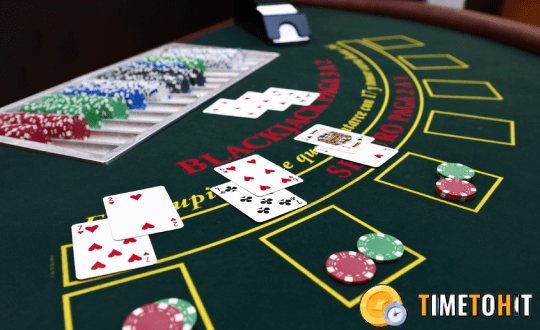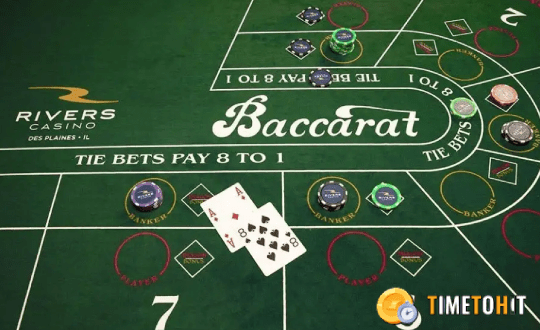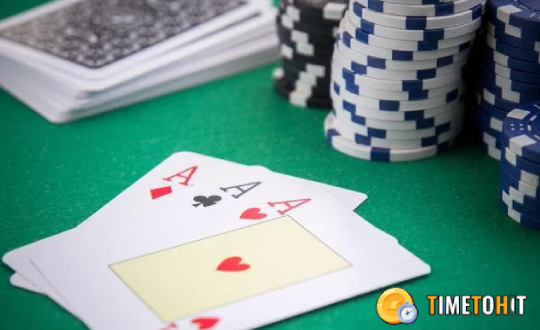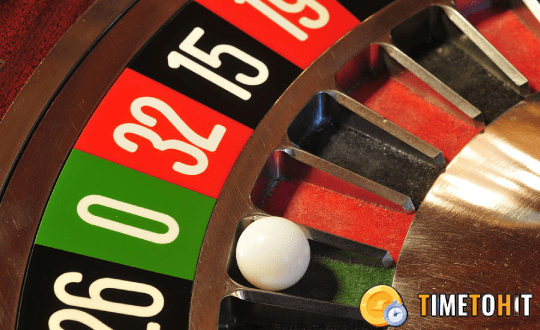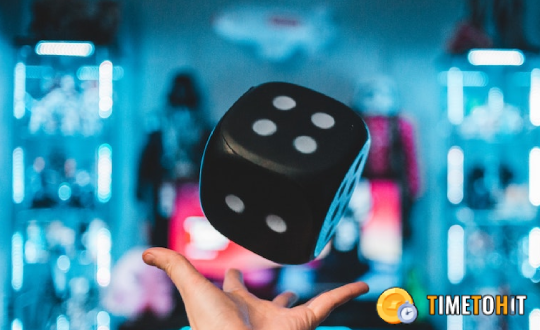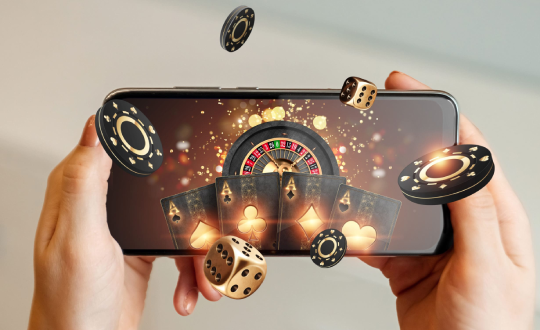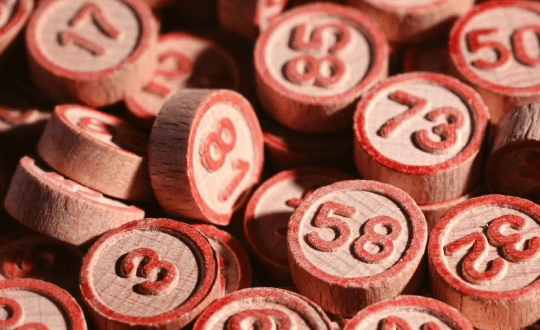Blackjack is one of the most straightforward games to get accustomed to at the casino as there are only a few rules to learn.
You initially start with two cards and the aim of the game is to get to 21, or beat the dealer’s cards. Going over 21 means you ‘bust’ and you automatically lose the game, getting more than the dealer means you win, and getting the same number as the dealer means you tie and retain your money for the next round.
The Ace card is worth either 11 or 1 and the picture cards (King, Queen, Jack) are worth 10. Hitting an Ace and a picture card, or a 10, is the ideal situation and is called, ‘Blackjack’.
The dealer must always request a new card when on 16 or lower, but the house has an edge of 0.5% in traditional Blackjack. The reason for the house edge in Blackjack is because one of the dealer’s cards is not exposed and players must make decisions based on intuition and faith, and therefore can go bust before even knowing what cards they need to beat.
If you win a hand you double the money you bet, if you lose you lose your money, and if you win with a Blackjack you traditionally win 1.5 times the bet.
Blackjack Strategies
There are four categories of Blackjack hands that you’re going to face and should memorise. Of course, these strategies won’t win you ever hand, but they give you the best possible opportunity to beat the house:
Hard Hands
A hard hand is classified as a hand which simply doesn’t include an Ace. You should always ‘hit’ on a hard hand that totals 11 or less as there is no risk, and no way you’ll go bust when receiving your next card.
You should also always ‘stand’ or ‘stick’ on a hand that totals between 17 and 21, but it gets a little bit trickier when you get cards that total between 12 and 16, and it all depends on what cards the dealer is showing.
If you have 13-16 and the dealer is showing a 6 or lower you should stand, if they’re showing a 7 or higher you should hit. The reason for this is that a 10 is the most likely card in the game of blackjack as there are four different types of 10 you can hit. If you assume the other card that the dealer has is a 10 and they have a 6, that total is 16 and therefore the dealer must hit which is a risky move. If it’s a 7 that they are showing, and you presume they have a 10, they have 17 which means the dealer sticks, so you need to think about beating that total.
Soft Hands
A soft Blackjack hand is a hand which includes an Ace where you can either play the ace as a 1 or an 11. Hitting an ace gives you the opportunity to hit on your next card without risking going bust.
There are quite a few permutations with soft hands in Blackjack, though there are only 8 possible soft totals.
If you have a soft 13 or 14 you should hit unless the dealer shows a 5 or 6 and then you should double down.
On a soft 15 or 16 you should double down if the dealer is showing 4 through to 6, otherwise, you should double down.
With a soft 17 you should hit if the dealer has a 2 or an 8 or higher, you should stand on a 7, and you should double down on 3 through to 6.
On a soft 18 you should double down if the dealer is showing 3 and 4, you should stand if they’re showing 2, 7, 8 or Ace, and you should hit if the dealer is showing 9 or 10.
Finally, you should always stand with a soft 20 or 19, and of course, if you have 21 you have Blackjack!
Doubling Down
Doubling down means you double the bet on your hand, but consequently, you will only be able to receive one more card.
You should always double down on 11 unless the dealer is showing an Ace because, as 10 is the most likely card, a 10 added to 21 wins or at least ties you the game, unless the dealer hits Blackjack (which would be likely if they were showing an Ace).
You should also double on a 9 if a dealer is showing a 3 to 6, and you should also double on a 10 unless the dealer is showing a 10 or Ace.
There are more double down potentials in the next section.
Splitting Hands
If you’re dealt the same numbers you have the option to double your bet and split your cards, putting a single bet on each hand.
You should always split on aces of course, as you then have a potential of nailing two Blackjacks. You should also always split on 8’s because two 8’s gives you the unenviable total of 16.
You should never split fours or fives.
If the dealer is showing 3 to 6 and you have a 6 you should always split.
You should split 7’s if the dealer is showing a 2 through to 7.
And you should always split 9’s if the dealer is showing a 7.
10 blackjack facts you might not have known
You may know it as "21" but blackjack is the common name for one of the most popular casino games in the world. It has helped sell millions of books, featured in movies starring the likes of Tom Cruise, Dustin Hoffman, and Robert De Niro, and won players millions in the process. But did you know that Napoleon used to play it everyday? Or that a magician in the mid-20th century invented a piece of equipment used by all casinos today? Below are 10 facts you may not have known.
The house edge of blackjack is as little as 1%
What? Less than 1%? This game is easy money then! Wrong! Due to things like card counting (we’ll get onto this later) and other strategies aimed at beating the dealer, numerous rules and variants were created to make sure the casino didn’t lose out too much. So certain rules need to be applied to keep the house edge below 1%. A breakdown of that can be found on the game's Wikipedia page.
Blackjack is one of the oldest gambling games in history
The game originated in France in the 1700s but there’s a debate over its validity. Then it was known as vingt-et-un (twenty-and-one) but in the 15th century, a game called trentuno (thirty-one) existed in Italy. A game called ventiuna (twenty-one) was mentioned in Miguel de Cervantes’ novel, Rinconete y Cortadillo in 1601. If that author sounds familiar, that’s because he also wrote the famous Don Quixote in 1605. Whatever you believe, it was a card game created in Europe a few centuries ago!
Emperor Napoleon played blackjack and enjoyed it more than any other card game.
The infamous emperor Napoleon Bonaparte was a huge fan. He reportedly played vingt-et-un during his exile on Elba but banned his soldiers from playing cards games as he saw them as a distraction.
The name "blackjack" was coined in the USA the 1920s
"21" was introduced to the United States after the French Revolution and many gambling houses offered special payouts to entice players. One involved the ace of spades and a black jack at a 10-1 payout. This hand became a "blackjack", and the name stuck.
There is a Blackjack Hall of Fame.
Located at Barona Casino in San Diego, California, is the Blackjack Hall of Fame. Inductees are awarded "a permanent lifetime comp for full room, food, and beverage, in exchange for each member’s agreement never to play on Barona’s tables." I can see why they’ve done that! Notable inductees include counting card father Ed Thorp, fellow mathematician and author Peter Griffin (no, not that Peter Griffin), and The Four Horsemen of the Apocalypse, a team of former US Army engineers who discovered the best playing strategy for the game in the 1950s.
Blackjack is a game that requires skill to play (and win)
Unlike slot games where it’s mainly luck (or random number generation), blackjack needs skill and strategy if you want to beat the casino. There have been countless books sold with different strategies and theories and while card counting is practically obsolete, its basis has helped many players regain some of the edge lost to the dealer.
A magician invented the card shoe
If you’ve ever seen a casino in a film or TV show, you’ll have seen the croupier take cards out of a box when dealing. This is known as a card shoe and was invented by magician John Scarne. When blackjack used to use only one deck, Scarne proposed a shoe to be used to avoid any kind of manipulation or sleight-of-hand. He would know - he was a magician and expert at card manipulation himself. The Nevada Gaming Control Board never made it a state ruling as Scarne intended, but the shoe was still used by the state’s casinos and more decks were added to increase the house edge and reduce the power of card strategies. And the reason it’s called a shoe? Because the original device resembled a woman’s high-heeled shoe.
The biggest blackjack win ever started with a huge loss
Don Johnson has won a pretty penny from it. He won $15 million from three Atlantic City’s casinos between December 2010 and April 2011. But it wasn’t an easy win. He had lost a lot of money ($500k) to begin with but the casinos offered him a discount and relaxed house rules in exchange for his custom. And they literally paid the price.
An American mathematician developed the idea of card counting
Most people know card counting from Rain Man and although there was some artistic licence employed to the concept in the film, it is very much a real thing. The aforementioned The Four Horsemen of the Apocalypse were the first to devise a strategy in 1956 and that lead a mathematician named Ed Thorp to create his own. In his 1963 book Beat the Dealer, he proposed an idea called card counting that allowed players to calculate when to hit or stand based on assigning numbers to different hands. As with any scientific theory, an experiment was required so he went out and tried it at numerous casinos and won. However, he was infamously thwarted when his use of special computers to “spy” on the dealers was caught. Las Vegas went on to ban him from all gambling establishments as a result.
16 isn’t so sweet in blackjack
A “16” hand is said to be the worst in the game, mathematically. It’s very much the midway because players are either afraid to hit and go bust or stick and see the dealer win. Splitting leads to a potential double loss. And with “hard” and “soft” hands, a "soft" 16 has its own problems. When you’re playing, indecisiveness can cost you dearly and a 16 is a real fly in the ointment. There are strategies to mitigate your losses but it’s a common hand and continues to make players wince at the sight of it.

 United Kingdom
United Kingdom
 Germany
Germany
 Finland
Finland
 Norway
Norway
 Canada
Canada
 Ireland
Ireland

